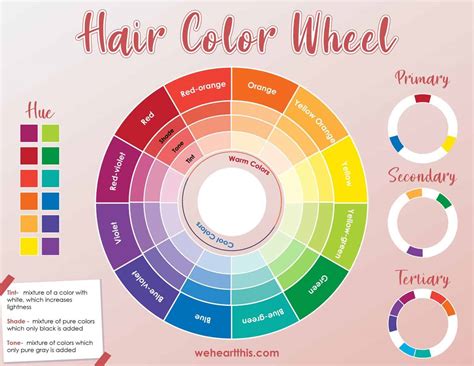Hair Color Wheel: Your 101 Guide to Coloring Hair Perfectly

The hair color wheel is an indispensable tool for stylists and colorists seeking to achieve stunning and accurate hair color transformations. This circular diagram displays a range of shades arranged according to their underlying tones and hues, providing a structured approach to mixing and applying colors.
The Basics of the Hair Color Wheel
The hair color wheel is divided into 12 primary, secondary, and tertiary colors. The primary colors, which cannot be created by mixing other colors, are:
- Red
- Yellow
- Blue
Secondary colors are created by combining two primary colors:
- Orange (Red + Yellow)
- Green (Yellow + Blue)
- Purple (Red + Blue)
Tertiary colors are formed by mixing a primary color with a secondary color, resulting in six shades:
- Red-Orange
- Yellow-Orange
- Yellow-Green
- Blue-Green
- Blue-Violet
- Red-Violet
Tone and Hue
- Tone refers to the darkness or lightness of a color, ranging from black (level 1) to blonde (level 10).
- Hue represents the actual color, such as red, blue, or green.
Colorists use the hair color wheel to:
- Identify client’s natural hair level: This determines the amount of lightening or darkening required to achieve desired results.
- Choose appropriate dyes: Colors should complement the client’s natural undertones and skin tone, with warm colors suiting warm skin tones and cool colors enhancing cool skin tones.
- Mix colors accurately: The wheel provides guidance on the proportions of different colors to create specific shades.
- Correct color mistakes: By understanding the color relationships, stylists can correct unwanted hues or balance overly intense colors.
Tips and Tricks
- Always perform a skin test before coloring to rule out allergic reactions.
- Use professional-grade hair color products for optimal results and hair health.
- Don’t overprocess hair as it can lead to damage and breakage.
- If you’re unsure about the color or application, consult a professional stylist.
- Maintain colored hair with color-protecting shampoos and conditioners.
- Determine your client’s natural hair level: Compare their hair to the hair color wheel and select the closest match.
- Choose your desired color: Select a color that complements your client’s skin tone and hair texture.
- Purchase a color correcting package if needed: This may be necessary if the client has unwanted brassy or green tones.
- Prepare the hair: Wash and towel dry the hair, then apply a protective barrier around the hairline.
- Apply the color: Mix the dye according to the manufacturer’s instructions and apply it to the hair section by section.
- Process according to the manufacturer’s instructions: The processing time will vary depending on the type of dye used.
- Rinse and condition: Rinse the hair thoroughly with cool water and apply a nourishing conditioner.
- Style as desired: Blow dry, curl, or straighten the hair as usual.
Pros:
- Provides a structured approach to hair coloring.
- Helps stylists correct color mistakes effectively.
- Enhances color accuracy and consistency.
Cons:
- Can be overwhelming for beginners.
- Requires practice and experience to use correctly.
- May not always account for variations in individual hair types.
Beyond traditional hair coloring, the hair color wheel can also inspire new applications, such as:
- Hair dye tattoos: Create temporary or semi-permanent hair art by applying dye to specific sections of hair in patterns or designs.
- Color-blocking: Experiment with bold and contrasting hair colors in geometric blocks for a unique and eye-catching look.
- Rainbow hair: Combine multiple shades from the hair color wheel to create a vibrant and whimsical rainbow effect on the hair.
The hair color wheel is an indispensable tool for hair professionals seeking to achieve precision and creativity in their coloring services. By understanding the principles and applications of the color wheel, stylists can enhance their skills and create stunning and transformative hair color transformations for their clients.
